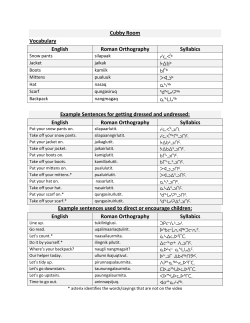
How to Check the Fit of New Tall Boots • Field boots are designed to drop, soften and crease
How to Check the Fit of New Tall Boots Follow these steps to assess the fit of your new tall boots: 1 Put on the breeches or riding tights and socks that you will wear with 1. your boots. 2 Pull on or zip up your boots. Initially, they should be difficult to tug 2. on (and off). If your boots have zippers, you should be able to zip them all the way up and snap the closure at the top while standing. The boots should feel uncomfortably snug around your calf without cutting off your circulation. If the boots are too loose, when they break in and stretch the boots will develop deep folds around your ankles that may press into your skin and cause friction. Also, if the boots are too loose, they will drop too much and be too short in height. 3 Check the height. For field 3. boots for which you want the maximum height after break-in, the front of the boot should rise to the middle of your kneecap. If you cannot see the kneecap at all, the boots are too tall. For dressage boots, the front of the boot should rise to just under your kneecap. Note height in back of knee. The boots will seem uncomfortably tall and will crease slightly at the top when you bend your knee, as shown in the photo. Wearing the boots will be uncomfortable during your first few rides. Note height on knee cap. Properly fitted new field boots Dover Equestrian Library The crease will disappear when the boots drop. You can see how high your boots will appear after the break-in phase by placing heel lifts in the footbed to raise your legs inside the boots. For a bit more comfort at the back of the knee, some people choose to ride in a heel lift until the boots finish breaking in. . 4 Check the feel of the footbed. 4. Make sure that you will be comfortable keeping the ball of your foot on a stirrup pad. If you have ordered a shoe size that is a little larger than you would normally wear in order to obtain a slightly taller boot height, place an air cushion, gel sole or other padded footbed in the shoe of the boot to take up extra space. © Dover Saddlery 2011 Tall Boot Fitting Tips Here are some overall points to consider about the fit of new tall boots. • Field boots are designed to drop, soften and crease around your ankle to allow for proper leg positions while riding. The amount of drop depends on the softness of the leather and on the boot cut. Because of the intended drop, it is important that new boots rise high enough at the knee initially, though the final height of your field boots will depend in part on the decisions you made when you ordered the boots. See the Mountain Horse Supreme High Rider Field Boot and the Ariat Quantam Pro Zip Field Boot for examples of field boots. Refer to “How to Measure for Stock Tall Boots” if you need help with sizing. • Dressage boots are crafted of stiffer leather than field boots, and are not designed to drop much or soften at the ankle. They should however stand high enough at the knee to help achieve an elegant, elongated leg in the saddle. For examples of dressage boots, see the Konigs Ladies Dressage Boot and the Cavallo Semi-Custom Boot. • All tall boots require an uncomfortable break-in time. Dover Saddlery offers an array of products to help you get used to your new boots from slippery Zocks that make boots easier to slide on to Der Dau Boot Stretch Spray for extra tight spots in the calf. If you have field boots, you can put Sergio Grasso Boot Cream on places of the leather where you need it to soften and bend, such as at the back of your knees and around the ankles. As your boots break in they will become more comfortable to wear. Related Topics How to Measure for Stock Tall Boots How to Care for Tall Riding Boots How to Prolong the Life of Boot Zippers For more assistance or to request a catalog, call 1-800-989-1500 to speak with a Dover Saddlery product advisor, or stop by any of our retail stores. Visit DoverSaddlery.com for a complete store listing and full product offering.
© Copyright 2025











